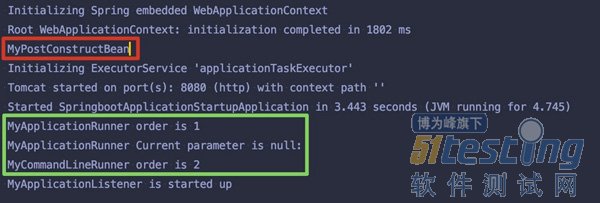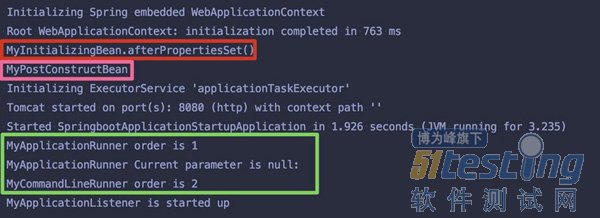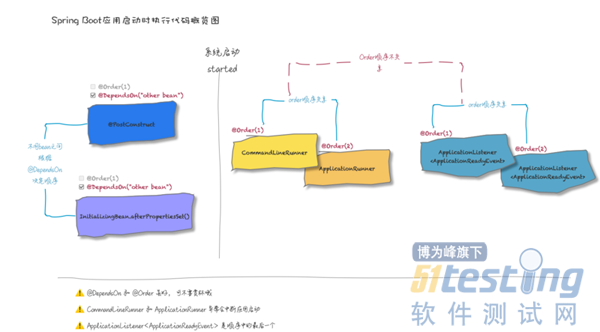前言
有时候我们需要在应用启动时执行一些代码片段,这些片段可能是仅仅是为了记录 log,也可能是在启动时检查与安装证书 ,诸如上述业务要求我们可能会经常碰到
Spring Boot 提供了至少 5 种方式用于在应用启动时执行代码。我们应该如何选择?本文将会逐步解释与分析这几种不同方式
CommandLineRunner
CommandLineRunner 是一个接口,通过实现它,我们可以在 Spring 应用成功启动之后 执行一些代码片段
@Slf4j @Component @Order(2) public class MyCommandLineRunner implements CommandLineRunner { @Override public void run(String... args) throws Exception { log.info("MyCommandLineRunner order is 2"); if (args.length > 0){ for (int i = 0; i < args.length; i++) { log.info("MyCommandLineRunner current parameter is: {}", args[i]); } } } } |
当 Spring Boot 在应用上下文中找到 CommandLineRunner bean,它将会在应用成功启动之后调用 run() 方法,并传递用于启动应用程序的命令行参数
通过如下 maven 命令生成 jar 包:
| mvn clean package |
通过终端命令启动应用,并传递参数:
| java -jar springboot-application-startup-0.0.1-SNAPSHOT.jar --foo=bar --name=rgyb |
查看运行结果:
到这里我们可以看出几个问题:
命令行传入的参数并没有被解析,而只是显示出我们传入的字符串内容 --foo=bar,--name=rgyb,我们可以通过 ApplicationRunner 解析,我们稍后看
在重写的 run() 方法上有 throws Exception 标记,Spring Boot 会将 CommandLineRunner 作为应用启动的一部分,如果运行 run() 方法时抛出 Exception,应用将会终止启动
我们在类上添加了 @Order(2) 注解,当有多个 CommandLineRunner 时,将会按照 @Order 注解中的数字从小到大排序 (数字当然也可以用复数)
不要使用 @Order 太多
看到 order 这个 "黑科技" 我们会觉得它可以非常方便将启动逻辑按照指定顺序执行,但如果你这么写,说明多个代码片段是有相互依赖关系的,为了让我们的代码更好维护,我们应该减少这种依赖使用
小结
如果我们只是想简单的获取以空格分隔的命令行参数,那 MyCommandLineRunner 就足够使用了
ApplicationRunner
上面提到,通过命令行启动并传递参数,MyCommandLineRunner 不能解析参数,如果要解析参数,那我们就要用到 ApplicationRunner 参数了
@Component @Slf4j @Order(1) public class MyApplicationRunner implements ApplicationRunner { @Override public void run(ApplicationArguments args) throws Exception { log.info("MyApplicationRunner order is 1"); log.info("MyApplicationRunner Current parameter is {}:", args.getOptionValues("foo")); } } |
重新打 jar 包,运行如下命令:
| java -jar springboot-application-startup-0.0.1-SNAPSHOT.jar --foo=bar,rgyb |
运行结果如下:
到这里我们可以看出:
同 MyCommandLineRunner 相似,但 ApplicationRunner 可以通过 run 方法的 ApplicationArguments 对象解析出命令行参数,并且每个参数可以有多个值在里面,因为 getOptionValues 方法返回 List<String> 数组
2. 在重写的 run() 方法上有 throws Exception 标记,Spring Boot 会将 CommandLineRunner 作为应用启动的一部分,如果运行 run() 方法时抛出 Exception,应用将会终止启动
3. ApplicationRunner 也可以使用 @Order 注解进行排序,从启动结果来看,它与 CommandLineRunner 共享 order 的顺序,稍后我们通过源码来验证这个结论
小结
如果我们想获取复杂的命令行参数时,我们可以使用 ApplicationRunner
ApplicationListener
如果我们不需要获取命令行参数时,我们可以将启动逻辑绑定到 Spring 的 ApplicationReadyEvent 上
@Slf4j @Component @Order(0) public class MyApplicationListener implements ApplicationListener<ApplicationReadyEvent> { @Override public void onApplicationEvent(ApplicationReadyEvent applicationReadyEvent) { log.info("MyApplicationListener is started up"); } } |
运行程序查看结果:
到这我们可以看出:
ApplicationReadyEvent 当且仅当 在应用程序就绪之后才被触发,甚至是说上面的 Listener 要在本文说的所有解决方案都执行了之后才会被触发,最终结论请稍后看
代码中我用 Order(0) 来标记,显然 ApplicationListener 也是可以用该注解进行排序的,按数字大小排序,应该是最先执行。但是,这个顺序仅用于同类型的 ApplicationListener 之间的排序,与前面提到的 ApplicationRunners 和 CommandLineRunners 的排序并不共享
小结
如果我们不需要获取命令行参数,我们可以通过 ApplicationListener<ApplicationReadyEvent> 创建一些全局的启动逻辑,我们还可以通过它获取 Spring Boot 支持的 configuration properties 环境变量参数
如果你看过我之前写的 Spring Bean 生命周期三部曲:
Spring Bean 生命周期之缘起
Spring Bean 生命周期之缘尽
Spring Aware 到底是什么?
那么你会对下面两种方式非常熟悉了
@PostConstruct
创建启动逻辑的另一种简单解决方案是提供一种在 bean 创建期间由 Spring 调用的初始化方法。我们要做的就只是将 @PostConstruct 注解添加到方法中:
@Component @Slf4j @DependsOn("myApplicationListener") public class MyPostConstructBean { @PostConstruct public void testPostConstruct(){ log.info("MyPostConstructBean"); } } |
查看运行结果:
从上面运行结果可以看出:
Spring 创建完 bean之后 (在启动之前),便会立即调用 @PostConstruct 注解标记的方法,因此我们无法使用 @Order 注解对其进行自由排序,因为它可能依赖于 @Autowired 插入到我们 bean 中的其他 Spring bean。
2. 相反,它将在依赖于它的所有 bean 被初始化之后被调用,如果要添加人为的依赖关系并由此创建一个排序,则可以使用 @DependsOn 注解(虽然可以排序,但是不建议使用,理由和 @Order 一样)
小结
@PostConstruct 方法固有地绑定到现有的 Spring bean,因此应仅将其用于此单个 bean 的初始化逻辑;
InitializingBean
与 @PostConstruct 解决方案非常相似,我们可以实现 InitializingBean 接口,并让 Spring 调用某个初始化方法:
@Component @Slf4j public class MyInitializingBean implements InitializingBean { @Override public void afterPropertiesSet() throws Exception { log.info("MyInitializingBean.afterPropertiesSet()"); } } |
查看运行结果:
从上面的运行结果中,我们得到了和 @PostConstruct 一样的效果,但二者还是有差别的
@PostConstruct 和 afterPropertiesSet 区别
afterPropertiesSet,顾名思义「在属性设置之后」,调用该方法时,该 bean 的所有属性已经被 Spring 填充。如果我们在某些属性上使用 @Autowired(常规操作应该使用构造函数注入),那么 Spring 将在调用afterPropertiesSet 之前将 bean 注入这些属性。但 @PostConstruct 并没有这些属性填充限制
2. 所以 InitializingBean.afterPropertiesSet 解决方案比使用 @PostConstruct 更安全,因为如果我们依赖尚未自动注入的 @Autowired 字段,则 @PostConstruct 方法可能会遇到 NullPointerExceptions
小结
如果我们使用构造函数注入,则这两种解决方案都是等效的
源码分析
请打开你的 IDE (重点代码已标记注释):
MyCommandLineRunner 和 ApplicationRunner 是在何时被调用的呢?
打开 SpringApplication.java 类,里面有 callRunners 方法
private void callRunners(ApplicationContext context, ApplicationArguments args) { List<Object> runners = new ArrayList<>(); //从上下文获取 ApplicationRunner 类型的 bean runners.addAll(context.getBeansOfType(ApplicationRunner.class).values()); //从上下文获取 CommandLineRunner 类型的 bean runners.addAll(context.getBeansOfType(CommandLineRunner.class).values()); //对二者进行排序,这也就是为什么二者的 order 是可以共享的了 AnnotationAwareOrderComparator.sort(runners); //遍历对其进行调用 for (Object runner : new LinkedHashSet<>(runners)) { if (runner instanceof ApplicationRunner) { callRunner((ApplicationRunner) runner, args); } if (runner instanceof CommandLineRunner) { callRunner((CommandLineRunner) runner, args); } } } |
强烈建议完整看一下 SpringApplication.java 的全部代码,Spring Boot 启动过程及原理都可以从这个类中找到一些答案
总结
最后画一张图用来总结这几种方式(高清大图请查看原文:https://dayarch.top/p/spring-...)
灵魂追问
上面程序运行结果, afterPropertiesSet 方法调用先于 @PostConstruct 方法,但这和我们在 Spring Bean 生命周期之缘起 中的调用顺序恰恰相反,你知道为什么吗?
MyPostConstructBean 通过 @DependsOn("myApplicationListener") 依赖了 MyApplicationListener,为什么调用结果前者先与后者呢?
为什么不建议 @Autowired 形式依赖注入
在写 Spring Bean 生命周期时就有朋友问我与之相关的问题,显然他们在概念上有一些含混,所以,仔细理解上面的问题将会帮助你加深对 Spring Bean 生命周期的理解
本文内容不用于商业目的,如涉及知识产权问题,请权利人联系博为峰小编(021-64471599-8017),我们将立即处理





















